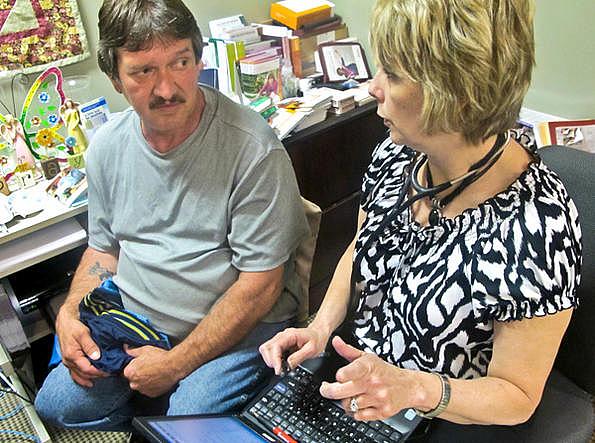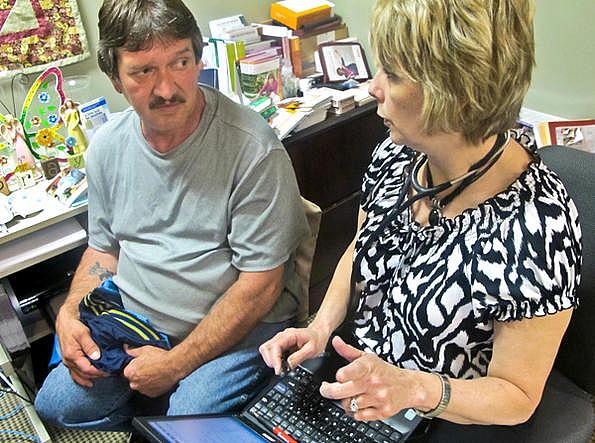Recognize diabetes before it's too late
West Virginia is among the top five on just about every national chronic disease list. The state leads the nation in diabetes and obesity, according to the Gallup Healthways poll.
Surveys show that many West Virginians do not realize obesity is a leading cause of many chronic diseases. Many also feel those diseases are hereditary, and there is nothing a person can do to prevent them.
The state's children raise major red flags for the future. West Virginia University screens thousands of schoolchildren every year. In 2010-11, they found that 24 percent of fifth-graders have high blood pressure, 26 percent have high cholesterol, and 29 percent are obese. Eighteen percent of kindergartners and 23 percent of second-graders are obese.
There has been little public discussion of this problem. "The Shape We're In" project aims to stir up that discussion. Written and photographed by Annenberg fellow Kate Long, it will be divided into three parts in The Charleston Gazette, the state's largest newspaper:
• Children at risk
• Programs that work
• Communities making a difference
Some segments will be accompanied by West Virginia Public Radio pieces.
Part 1: "This is a public health emergency"
Part 3: Putting the pieces together
Part 4: Health officials say W.Va. can reverse its chronic disease numbers
Part 5: W.Va. man: diabetes programs work
Part 7: Daily activity affordable, Department of Education says
Part 8: Wood researchers: Active kids do better academically
Part 9: Rocking the gym at 7:30 a.m.
Part 10: Nebraska school district lowers obesity rate
Part 12: 'Everyday heroes' saving own lives
Part 13: W.Va. ranks first in heart attack, diabetes, eight other categories
Part 15: Great Kanawha food fight
Part 17: W. Va. slammed with sugar
Part 18: Glenda and Jill vs. diabetes
Part 19: This is how bad diabetes can be
Part 20: Recognize diabetes before it's too late
Part 21: Logan hardest hit by diabetes
Part 22: Even if your relatives had diabetes, you don't have to


WILLIAMSON, W.Va. -- The winter of 2010-11, it snowed a lot in Mingo County. Fifty-four-year-old Everette Ray Roberts was shut in for days, "me and my dog," in a small trailer perched on a steep hillside near Matewan.
"I was constantly dizzy and thirsty," he remembers. "With all the snow, I wasn't getting out and walking around, doing stuff. I'd gained a lot of weight. My eyes got blurry.
A rugged bachelor, Roberts has three ruptured discs in his back "from heavy lifting," he said. "Every job I've ever worked was brute labor, steel mills, basic labor. That takes its toll on a person's body."
"I wondered if I was going nuts from being shut in. I'd get so shaky, shaky, sitting on the couch watching TV, and I was pouring down the 24-ounce bottles of pop, five or six of them a day. It was like adding gasoline to the fire, all that sugar, but I didn't know it.
"All I knew was, I was terrible thirsty. I kept a gallon of water sitting beside me for when I ran out of pop."
Then he started gasping for breath. "I couldn't sleep. I'd get real, real sweaty." He had to keep running to the bathroom. "I thought maybe it was high blood pressure or something."
"I didn't have a clue what was going on. I had no idea what danger I was in."
He was one of an estimated 69,000 West Virginians who have diabetes, but don't know it.
Roberts "grew up rough on a humungous farm" in Wayne County, he said, where "all us kids worked hard to make the place go, and our dad taught us to deal with problems and not complain." He toughed it out.
Living on an isolated Mingo hillside, "going to the doctor in the snow is not exactly easy, and it's expensive," he said.
When he finally did go, "the doctor said, you've got all the symptoms of diabetes. My sugar was up the high 400s. My A1C, the three-month blood sugar, was 12.5." Normal A1C is around 2. Anything above 7 is considered bad.
"The doctor said it was a good thing I didn't wait any longer to come in."
His doctor referred him to diabetes educator and nurse practitioner Vicki Lynn Hatfield in Williamson. Hatfield and her partner help about 500 of Mingo's estimated 3,500 diabetics figure out how to control it from day to day, despite sometimes-harsh realities of life: shortage of cash, two jobs, kids, and so on.
"I lucked out," Roberts said. "If it hadn't been for Vicki, I'd probably be in kidney failure now," he said.
He and Hatfield went over what he ate, how often he ate, his schedule, his physical activity. She had him keep a list. To get rid of his dizziness, shakiness and blurry vision, they planned specific ways he could change what he ate or when he ate and increase physical activity every day, They got his medicine adjusted.
Roberts went to Hatfield's group diabetes self-management classes at Williamson Memorial Hospital. He learned how to shop for food that wouldn't set off his blood sugar, how to read his own blood sugar levels, tricks of coping with depression.
"Everette is somebody who, once he found out how to control his diabetes, he took the reins," Hatfield said. A year later, his blood sugar was in normal range. He requires less medicine to keep it there.
"He doesn't have a lot of money and he doesn't have a lot of education, but he learned very quickly how to do it. And, just as important, he did it," Hatfield said.
"We've got plenty of patients who don't have a lot of education and income, but that doesn't have to stop them," she said. "Appalachian people in general are very capable. I have found that if I can get people the information, most will apply it, with whatever means they have."
"I recently saw a woman who was paying a neighbor $100 to drive her to Huntington to see a specialist who'd check her blood sugar, see her five minutes, maybe adjust her prescription, then tell her when to come back. She had had diabetes for 20 years, and in all that time, nobody'd ever talked with her about what she eats or how she could help herself with physical activity."
Hatfield taught her how to check her own blood sugar and manage her diet and increase her exercise. "Her blood sugar levels dropped enormously," Hatfield said. "She's so proud of herself. She had no idea she could do that."
"People are not born knowing the symptoms of diabetes, and they aren't born knowing how to control it," she said, "and it takes more than a 15-minute doctor visit to help them get a handle on all they need to know."
"There's a whole lot more to it than what I thought there'd be," Roberts said. Hatfield dished it out to him in small steps, he said. He learned what foods would keep him stable and how to lower his blood sugar by taking a walk, how to buy healthy foods on a budget.
"I stay on the move now, 24/7," he said. He eats better food and less food, he says. "I cook for myself. I take the skin off my chicken, and bake it instead of fry it. I make myself a lot of salads. I like salad and I put all kinds of stuff in them, vegetables, meat."
He lost more than 30 pounds, dropped from 271 to 240. By last fall, he had cut his A1C level down to 7. He quit drinking pop. He does yard work for others. "It's a lot of extra exercise," he said.
This month, his A1C is down to 5.1. He sees clearly. He is still losing pounds. "It's still a battle," he said in April, "but nothing like it was.
"I would tell anybody, the bottom line of it is: If you don't set it in your mind that you're going to get it under control, then it's not going to get better," he said. "It's up to you whether you do or you don't."
"I used to call Vicki every week, on Thursday," he said. "It really helped to have somebody to report in to," he said. "When I got discouraged, she kept me going." Now he checks in once a month.
"I wish I could have gotten to him earlier," Hatfield said. "And lots more like him."
A Matewan native, she keeps trying new ways to stamp out diabetes in her home county. Two years ago, she helped start a Mingo County diabetes coalition. Now they have a five-year grant for $50,000 a year through Marshall University to spread diabetes awareness and prevention through the county.
Hatfield now offers diabetes prevention classes. "People tell their neighbors what they learned. So it's spreading," she said.
The coalition plans to post symptoms of diabetes in store windows and telephone poles all over the county. "We want people to know they can catch it early. If we can get people to go after it like Everette has, our diabetes rate should drop."
